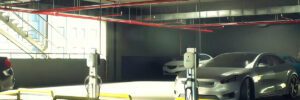TL;DR: If you’re a fan of sweater vests, growing bonsai trees in the quiet of your well-manicured home, actively avoid the gaze of fellow drivers, and you happen to have an extra $100k lying around, this is the car for you. Pre-orders for the AFEELA 1 are currently open, but solely in California. Interested buyers can secure a spot on the pre-order list with a $200 deposit. Base model Origin editions only come in black and start at $89,900 USD. The decked-out Signature variant arrives with a hefty price tag of $102,900 USD.
Wait, What New Car is This?
At this year’s 2025 Consumer Electronics Show in Las Vegas, Nevada, Sony and Honda officially announced the release of their joint-project, the AFEELA 1 EV, underscoring Honda’s ambitious attempt to crack into the luxury electric vehicle space. This slightly revised rendition of the original prototype–unveiled at CES 2024–looks production-ready with its aerodynamic wheels, AI functionality, minimalist interior, and premium infotainment systems. The new sedan measures 193.5 inches in length, slightly shorter than a 2024 Honda Accord but with a longer wheelbase. However, with an incredibly steep price tag and rather reserved (read: safe) aesthetics, the jury is still out regarding whether typically cost-conscious Honda consumers will be willing to shell out $100k on this latest offering. We’ll get the answer to that question soon enough, however, as pre-orders are now officially open—via a $200 refundable deposit—to those living in the green state of perpetual sunshine, California.
Model Variants and Pricing
This new Honda-Sony partnership reports it will offer the AFEELA 1 in two trim packages: the Origin and the more upscale Signature editions. Starting at $89,900 USD, the base-model is, interestingly enough, available in any color you’d like, as long as that color is black. Donning 19-inch alloy wheels, and ample room and technology to appease 4-5 adults, deliveries of this base model are expected to arrive sometime in 2027. Moving up a tier, the top-of-the-line Signature variant comes in at an eye-watering $102,900 USD. This black-tie bougie version offers a further array of exciting color options, including and quite limited to black, gray, and white. Featuring 21-inch alloy wheels, rear screens, a digital rear-view mirror, and more, Honda fans can expect deliveries of this rendition to arrive stateside first, as early as mid-2026.
Following in the footsteps of other luxury automakers, AFEELA 1 customers will also have to pay for the ability to use many of the embedded technological features for which they already paid a premium. And while the accounting team at Sony Honda Mobility ever so “graciously” offers new owners a three-year “complimentary” subscription for these types of features, after that initial period, these features become subscription-based options instead. This alarming new trend of subscription-based “features” forces consumers to continue paying for the “rights” to use the features that already came pre-installed on their vehicles. These subscription-based features often target beloved creature comforts, things like heated seats and steering wheels, premium audio experiences, active driving assistance, and voice recognition. Needless to say, after already asking customers to shell out $100k for a vehicle—and in this case, a Honda no-less—we’re all a bit miffed by this unfortunate trend towards luxury rental-ownership.
Design and Features
While the AFEELA 1 intends to boast a sleek design with traditional side-view mirrors and substantial headlights, plenty of CES attendees reported feeling a bit underwhelmed by the fanfare over what they found to be mild, even boring design choices.
As one event attendee poignantly quipped, “It basically looks a lot like a Toyota Crown.”
All joking aside, the AFEELA 1 is offers passengers a tract of touchscreen acreage spanning the width of the dashboard, wireless phone chargers, and an inward-facing camera, which, honestly, leaves us a bit unnerved about occupant privacy. It’s invasive enough that cellphone companies and app developers track our thoughts and actions through our phones, but adding corporate cameras to one of the last true vestiges of our private lives feels, for this editor anyway, like a step gone too far. The rest of the cabin design emphasizes a neutral and minimalist aesthetic, aiming to balance high tech edginess with a contrast of natural and supple materials similar to the clean design concepts found in Volvo interiors. Internal spy camera aside, the vehicle includes another 45 cameras and myriad sensors to enable advanced driver-assistance systems and other autonomous driving capabilities.
Performance and Technology
Central to the AFEELA 1’s appeal for many is its AI-powered technology. The AFEELA 1 Intelligent Drive system introduces autonomous driving capabilities that stop just shy of replacing Jeeves, your personal driver. Meanwhile, the AFEELA Personal Agent acts as a virtual assistant while traveling the open road. Sony’s expertise in software and entertainment shines through the interior with dual rear-seat screens—in the Signature model—to supply kids and coworkers alike with a personalized and immersive in-car experience. The EV supports 5G network connectivity for seamless integration with smart devices, enhanced navigation, communication, and real-time updates for traffic and apps. This robust 5G integration system also ensures those “creature comfort” subscriptions of yours stay up-to-date.
All AFEELA 1 models are equipped with a dual-motor all-wheel-drive powertrain, each producing a somewhat meager 241 horsepower. That said, it’s likely that Honda is simply trying taking a more practical approach here—after all it is a Honda. As other automakers continue to roll out additional EV models, it’s likely that we’ll continue to see the industry move toward lower-powered EVs in the future. Boy racer egos aside, it’s a move that admittedly makes sense. Not every vehicle, nor every EV owner for that matter, needs or even wants a 2-second 0-60 time from their grocery getter. Lower powered electric vehicles can sport smaller batteries and lighter drivetrains, making them greener, more efficient, and admittedly, more practical. Riding on a combination air-spring suspension system, the AFEELA 1 ensures a smooth and comfortable ride across city and country settings alike.
Future Models and Plans
Looking ahead, Honda plans to introduce two new models by the end of the decade, including a crossover-sized SUV built on the same sedan platform, and a more affordable compact model designed to compete with the likes of the Toyota Corolla. Expect SUV models to arrive mid-2027 and compact models to hit dealership floors by 2028. Honda reports their more cost-friendly compact models will feature trickled-down options and technologies from their much costlier siblings, in an effort to bring costs down for its entire EV lineup.
Sony and Honda hope their strategic partnership enables them to make an impact in the luxury EV marketplace. With its AI-driven features, entertainment-focused design, and impressive range, the AFEELA 1 has a chance to earn a place at the table of electric vehicles. However, Honda’s pricey gamble on its rather mundane aesthetics leaves investors and fan boys alike a bit on edge.







